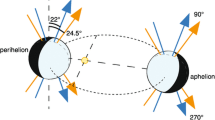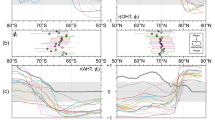Abstract
The contributions of expanded continental ice, reduced atmospheric CO2, and changes in land albedo to the maintenance of the climate of the last glacial maximum (LGM) are examined. A series of experiments is performed using an atmosphere-mixed layer ocean model in which these changes in boundary conditions are incorporated either singly or in combination. The model used has been shown to produce a reasonably realistic simulation of the reduced temperature of the LGM (Manabe and Broccoli 1985b). By comparing the results from pairs of experiments, the effects of each of these environmental changes can be determined.
Expanded continental ice and reduced atmospheric CO2 are found to have a substantial impact on global mean temperature. The ice sheet effect is confined almost exclusively to the Northern Hemisphere, while lowered CO2 cools both hemispheres. Changes in land albedo over ice-free areas have only a minor thermal effect on a global basis. The reduction of CO2 content in the atmosphere is the primary contributor to the cooling of the Southern Hemisphere. The model sensitivity to both the ice sheet and CO2 effects is characterized by a high latitude amplification and a late autumn and early winter maximum.
Substantial changes in Northern Hemisphere tropospheric circulation are found in response to LGM boundary conditions during winter. An amplified flow pattern and enhanced westerlies occur in the vicinity of the North American and Eurasian ice sheets. These alterations of the tropospheric circulation are primarily the result of the ice sheet effect, with reduced CO2 contributing only a slight amplification of the ice sheet-induced pattern.
Similar content being viewed by others
References
Berlyand TG, Strokina LA, Greshnikova LE (1980) Zonal cloud distribution on the earth. Meteorol Gidrol 3: 15–23
Bourke W (1974) A multi-level spectral model I. Formulation and hemispheric integrations. Mon Weather Rev 102: 687–701
Broecker WS (1984) Carbon dioxide circulation through ocean and atmosphere. Nature 308: 602
Chervin RM, Schneider SH (1976) On determining the statistical significance of climate experiments with general circulation models. J Atmos Sci 33: 405–412
CLIMAP Project Members (1976) The surface of the ice-age earth. Science 191: 1131–1137
CLIMAP Project Members (1981) Seasonal reconstructions of the earth's surface at the last glacial maximum. Geol Soc Am Map Chart Ser, MC-36
Gates WL (1976a) Modeling the ice-age climate. Science 191: 1138–1144
Gates WL (1976b) The numerical simulation of ice-age climate with a global general circulation model. J Atmos Sci 33: 1844–1873
Gordon CT, Stern WF (1982) A description of the GFDL global spectral model. Mon Weather Rev 110: 625–644
Hansen J, Lacis A, Rind D, Russell G, Stone P, Fung I, Ruedy R, Lerner J (1984) Climate sensitivity: analysis of feedback mechanisms. In: Hansen J, Takahashi T, (eds) Climate processes and climate sensitivity. Maurice Ewing Series, 5, pp 130–163
Hays JD, Imbrie J, Shackleton NJ (1976) Variations in the earth's orbit: pacemaker of the ice age. Science 194: 1121–1132
Kutzbach JE, Guetter PJ (1986) The influence of changing orbital parameters and surface boundary conditions on climate simulations for the past 18 000 years. J Atmos Sci 43: 1726–1759
Lamb HH, Woodroffe A (1970) Atmospheric circulation during the last ice age. Quat Res 1: 29–58
London J (1957) A study of atmospheric heat balance, final report. Contract AF19(122)-165 DDC, Coll of Engl, New York University, (NTIS AD 117227)
Manabe S, Broccoli AJ (1985a) The influence of continental ice sheets on the climate of an ice age. J Geophys Res 90: 2167–2190
Manabe S, Broccoli AJ (1985b) A comparison of climate model sensitivitiy with data from the last glacial maximum. J Atmos Sci 42: 2643–2651
Manabe S, Bryan K, Spelman MJ (1979) A global ocean-atmosphere climate model with seasonal variation for future studies of climate sensitivity. Dyn Atmos Ocean 3: 393–426
Manabe S, Hahn DG (1977) Simulation of the tropical climate of an ice age. J Geophys Res 82: 3889–3911
Manabe S, Stouffer RJ (1980) Sensitivity of a global climate model to an increase of CO2 concentration in the atmosphere. J Geophys Res 85: 5529–5554
Milankovitch M (1941) K Serb Akad Beogr Spec Publ 132, translated from German by the Israel Program for Scientific Translations, Jerusalem
Neftel A, Oeschger H, Schwander J, Stauffer B, Zumbrunn R (1982) Ice core sample measurements give atmospheric CO2 content during the past 40 000 yr. Nature 295: 200–223
Shackleton NJ, Hall MA, Line J, Shuxi C (1983) Carbon isotope data in core V19-30 confirm reduced carbon dioxide concentration in the ice age atmosphere. Nature 306: 319–322
Williams J, Barry RG, Washington WM (1974) Simulation of the atmospheric circulation using the NCAR global circulation model with ice age boundary conditions. J Appl Meteorol 13: 305–317
Author information
Authors and Affiliations
Rights and permissions
About this article
Cite this article
Broccoli, A.J., Manabe, S. The influence of continental ice, atmospheric CO2, and land albedo on the climate of the last glacial maximum. Climate Dynamics 1, 87–99 (1987). https://doi.org/10.1007/BF01054478
Received:
Accepted:
Issue Date:
DOI: https://doi.org/10.1007/BF01054478




